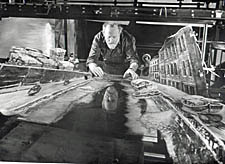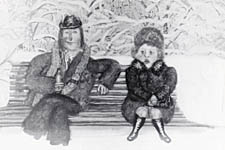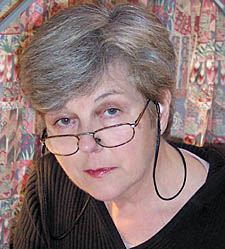|
|
 |
| |
Tales by a Russian master
Until now, Yuri Norstein has been an obscure genius, writes Jane Wright
Yuri Norstein and Tale of Tales: An Animator’s Journey
by Clare Kitson.
John Libbey, £17.50.
WHEN Clare Kitson started to publicise her book on film masterpiece
The Tale of Tales, she knew she was up against it.
The 1979 work by Russian director Yuri Norstein may consistently
have been voted by experts the best animated film of all time,
but as Clare, former commissioning editor for animation at Channel
4 and who lives in Parliament Hill, puts it: “Here was
someone people hadn’t heard of, writing about someone people
hadn’t heard of”.
Nevertheless, she set about her task with the same “doggedness”
she admires in Norstein, a thorn in the side of the Russian
authorities his whole career long.
Last month her success was evident as her book was launched
at a sell-out promotional screening of the film in the West
End, followed by a question and answer session on Norstein and
the Tale of Tales, where Clare shared the stage with Booker
prize-winning author and cultural commentator AS Byatt.
Indeed, Miss Byatt hadn’t heard of the film at all before
Clare got in touch and made her a Norstein fan.
Who else could have written the foreword to Clare’s book
but Nick Park himself – the Oscar-winning animator behind
Wallace and Gromit, who declares he is “enchanted”
by Norstein’s spell.
Now the success of the film screening is to be repeated with
a second showing of the Tale of Tales at the Curzon Cinema Soho
next Saturday, (February 25) together with two other Norstein
animations, The Heron and the Crane and Hedgehog in the Fog,
a favourite film of radio DJ Johnny Vaughan.
Clare’s book, Yuri Norstein and the Tale of Tales: An Animator’s
Journey, sees this complex and mysterious film as “a series
of reflections about childhood, family life and community”
which unfold in separate, apparently unrelated scenes or “micro-histories”.
The whole is knitted together by a frequently appearing character
from a Russian lullaby, the Little Wolf, whose “burning
look and sense of longing dictate the mood of the piece”.
She admits to me: “It is very hard to show the Tale of
Tales to a non-specialist audience, but whenever I have, the
response is amazing. People always say ‘I don’t know
what it’s about, but it’s so beautiful’. Everyone,
from psychoanalysts to oilmen, is completely bowled over.
“In the Soviet Union, animators like Norstein were not
conceived of as entertainers. They’ve all done God knows
how many years at art school and they go to dinner with concert
pianists.
We learn in Clare’s book that Norstein was at first a reluctant
animator.
A Jew from a working class suburb in Moscow, his ambition to
be an artist was stymied first by the routine anti-Semitism
he experienced in his post Second World War boyhood under Stalin’s
rule.
Recommended for special art coaching at age 11 because of his
prodigious talent, he was really beginning to shine when he
was one day simply told not to come back. The young Norstein
went home and cried his eyes out.
Later on, his lack of ability to pass exams meant he failed
to get in to four different art schools and accepted a training
at the Soviet animation school just to save himself from a mundane
job in a furniture factory.
But Clare Kitson says the most political aspect of The Tale
of Tales is Norstein’s trademark bloodymindedness.
Regardless of the Soviet authorities‚ approval he wanted
to make his film.
“He’s a dangerous obsessive,” she says. “Very
difficult, very disapproving of other animators and very brave.”
Indeed, the film was banned at first, because Clare writes,
the Soviet censors “simply did not have a clue what it
was about”.
She explains: “It did not look seditious, but who could
be sure?” And, as the film began to win prizes overseas,
Yuri Norstein was certainly not allowed to travel to collect
them.
Yet perhaps the greatest irony of Norstein’s story is that
“this man who spent his whole life fighting against the
system now can’t function professionally at all.”
Now the Soviet system is destroyed, Norstein has the freedom
to make whatever film he wants, but without mass market appeal,
there’s no capitalist cash for him to do so. He’s
not a businessman and he just won’t compromise.
Clare says: “Nick Park’s company, Aardman Animations,
thought about helping Norstein financially, but he said ‘No’
and accepted from them only a few boxes of lightbulbs.”
Now, with her book on Norstein, Claire continues to battle against
“people’s feeling either that animation is difficult,
or their association of it with cartoons, meaning it‚s
for children.”
She concludes: “But once I get stuck in, I keep on. After
all, on its very first showing abroad, The Tale of Tales simply
became known as ‘The Masterpiece’.”
|
|
 |
|



